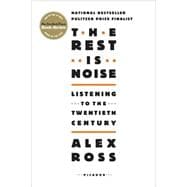
Note: Supplemental materials are not guaranteed with Rental or Used book purchases.
Purchase Benefits
What is included with this book?
Alex Ross, music critic for The New Yorker, is the recipient of numerous awards for his work, including two ASCAP Deems Taylor Awards for music criticism, a Holtzbrinck Fellowship at the American Academy in Berlin, a Fleck Fellowship from the Banff Centre, and a Letter of Distinction from the American Music Center for significant contributions to the field of contemporary music. The Rest is Noise is his first book.
| Preface | p. xv |
| Where to Listen | p. xix |
| 1900-1933 | |
| The Golden Age: Strauss, Mahler, and the Fin de Siecle | p. 3 |
| Doctor Faust: Schoenberg, Debussy, and Atonality | p. 36 |
| Dance of the Earth: The Rite, the Folk, le Jazz | p. 80 |
| Invisible Men: American Composers from Ives to Ellington | p. 130 |
| Apparition from the Woods: The Loneliness of Jean Sibelius | p. 171 |
| City of Nets: Berlin in the Twenties | p. 194 |
| 1933-1945 | |
| The Art of Fear: Music in Stalin's Russia | p. 235 |
| Music for All: Music in FDR's America | p. 284 |
| Death Fugue: Music in Hitler's Germany | p. 333 |
| 1945-2000 | |
| Zero Hour: The U.S. Army and German Music, 1945-1949 | p. 373 |
| Brave New World: The Cold War and the Avant-Garde of the Fifties | p. 386 |
| "Grimes! Grimes!": The Passion of Benjamin Britten | p. 447 |
| Zion Park: Messiaen, Ligeti, and the Avant-Garde of the Sixties | p. 483 |
| Beethoven Was Wrong: Bop, Rock, and the Minimalists | p. 515 |
| Sunken Cathedrals: Music at Century's End | p. 558 |
| Epilogue | p. 589 |
| Notes | p. 593 |
| Suggested Listening | p. 651 |
| Acknowledgments | p. 653 |
| Index | p. 657 |
| Table of Contents provided by Ingram. All Rights Reserved. |
The New copy of this book will include any supplemental materials advertised. Please check the title of the book to determine if it should include any access cards, study guides, lab manuals, CDs, etc.
The Used, Rental and eBook copies of this book are not guaranteed to include any supplemental materials. Typically, only the book itself is included. This is true even if the title states it includes any access cards, study guides, lab manuals, CDs, etc.
Excerpted from The Rest Is Noise: Listening to the Twentieth Century by Alex Ross
All rights reserved by the original copyright owners. Excerpts are provided for display purposes only and may not be reproduced, reprinted or distributed without the written permission of the publisher.